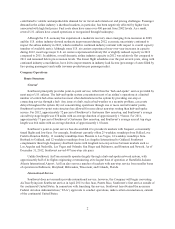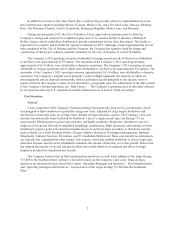Southwest Airlines 2012 Annual Report Download - page 20
Download and view the complete annual report
Please find page 20 of the 2012 Southwest Airlines annual report below. You can navigate through the pages in the report by either clicking on the pages listed below, or by using the keyword search tool below to find specific information within the annual report.• use of electric ground power for aircraft air and power at the gate;
• deployment of auto-throttle and vertical navigation to maintain optimum cruising speeds;
• implementation of new engine start procedures to support the introduction of new single engine taxi
procedures;
• adjustment of the timing of auxiliary power unit starts on originating flights to reduce auxiliary
power unit usage; and
• reduced aircraft engine idle speed while on the ground, which also increases engine life.
The Company has also taken significant steps towards Required Navigation Performance (“RNP”)
operations. RNP is part of the FAA’s strategy to modernize the U.S. Air Traffic Control System by addressing
limitations on air transportation capacity and making more efficient use of airspace. RNP combines the
capabilities of advanced aircraft avionics, GPS (Global Positioning System) satellite navigation (instead of less
precise ground-based navigation), and new flight procedures to (i) enable aircraft to carry navigation capabilities
rather than relying on airports; (ii) improve operational capabilities by opening up many new and more direct
airport approach paths to produce more efficient flight patterns; and (iii) conserve fuel, improve safety, and
reduce carbon emissions. Southwest began conducting GPS approach procedures during the first quarter of 2010,
completed RNP training of nearly 6,000 pilots in November 2010, and commenced RNP procedures in revenue
service in January 2011. In the first twenty days of RNP activation, Southwest performed 1,400 RNP approaches,
and, by the end of 2011, Southwest had conducted 6,790 RNP approaches; however, for reasons out of its
control, by the end of 2011 Southwest’s total number of RNP approaches had slowed to fewer than 400 per
month. Southwest performed 2,870 RNP approaches during 2012, including 956 in the fourth quarter as RNP
approaches became available at several additional airports. Southwest must rely on RNP approaches published by
the FAA, and the rate of introduction of RNP approaches has been slower than expected, with fuel efficient RNP
approaches currently available at only 29 airports. In addition, even at airports with approved RNP approaches,
the clearance required from air traffic controllers to perform RNP approaches is often not granted. As a result of
the FAA’s recent lack of emphasis on continuing to implement this technology and the Company’s continued
retirement of its older Classic (737-300/500) aircraft, the Company has decided not to equip its Classic aircraft
with RNP capabilities.
Aggressive Promotion of the Company’s Points of Differentiation from its Competitors
During 2012, the Company continued to benefit from, and aggressively market, Southwest’s points of
differentiation from its competitors. For example, Southwest continues to be the only major U.S. airline that does
not impose additional fees for first and second checked bags. Through its “Bags Fly Free®” marketing campaign,
Southwest has continued to aggressively promote this point of differentiation from its competitors. The Company
believes its decision not to charge for first and second checked bags on Southwest, as reinforced by the
Company’s related marketing campaign, has driven an increase in Southwest’s market share and a resulting net
increase in revenues.
Southwest is also the only major U.S. airline that does not impose a fee on any of its fares for a Customer
change in flight plans. The Company has continued to incorporate this key point of differentiation in its marketing
campaigns. The campaigns highlight the importance to Southwest of Customer Service by showing that Southwest
understands plans can change and therefore does not charge a change fee. While a Customer may pay a difference
in airfare, the Customer will not be charged a change fee on top of any difference in airfare. As discussed below
under “Ancillary Services and Fees,” during 2013, Southwest intends to implement a service charge for reuse of
funds associated with “Wanna Get Away” tickets that are not canceled or changed prior to departure.
Also unlike most of its competitors, Southwest does not impose additional fees for items such as seat
selection, fuel surcharges, snacks, curb-side checkin, and telephone reservations. In addition, Southwest allows each
ticketed Customer to check one stroller and one car seat free of charge, in addition to the two free checked bags.
12
























